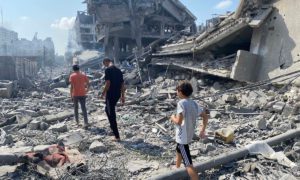Kashmir’s unionist camp has raised a war cry of unity as New Delhi flew supplementary sorties and reactivated the Article 35-A rumour mill in the valley. Amid escalating panic and hysteria, even as Governor Satya Pal Malik plays fireman, the grim unionists took out a desperate march to seek answers from the ‘oblivious’ Raj Bhavan.
Gates of Fairview on the commanding Gupkar Road were momentarily closed, as ex-chief minister Mehbooba Mufti threatened a protest march towards Lal Chowk, at 9:30 pm, on Friday, August 2, 2019. The desperate bid that came after a hurriedly-conveyed presser, beckoned the ailing Abdullah’s address, before the strange bedfellows of Kashmir’s unionist camp came out together for a fleetingly freaky ‘night-out’ at Raj Bhavan.
Governor Malik lived up to his ‘all is well’ reputation, telling the anxious visitors that they should not pay heed to the rumours created by the troop build-up and a slew of government circulars. But unlike last time, Governor Malik, habitual of bashing the local unionists for “Kashmir mess”, didn’t dismiss the circulars as “invalid”.
Scribes and supporters of the messy mainstream—who shuttled between Gupkar and Raj Bhavan on Friday night—could tell, rather detail the desperate measures in desperate times, for the Kashmir’s “sidelined camp”.
A day later, Omar Abdullah followed suit, and ended up stating the obvious—‘the call lies with the centre’—in his presser, where he apparently tried his best to allay fears and panic in the valley.
It’s a fight for the state’s identity—is now the rallying call of Kashmiri unionists, some of whom make no bones about how they were “shown their worth” by New Delhi’s new dispensation.
However, in the panic-gripped valley, not many are buying the unionists’ arguments.
“The desperation of these unionists only reflects their own political endangerment,” said Mohsin Rafiq, who queued up for panic-buying in Srinagar on Friday evening. “They may now shake Earth and Heavens, but we Kashmiris know that only these people are responsible for the present crisis in Kashmir.”
Not everyone, however, is in a bashing mode.
Many believe that the local unionists are the last refuge in the fight against any ‘political misadventure’ and to safeguard J&K’s remaining autonomous character.
“One can’t rule out their importance right now,” said Kaiser Hameed, a banker. “They may be faking it for the sake of their own political survival right now, but even their posturing matters for stopping any political misadventure in the state.”
The unity talk among Kashmiri unionists attained a new pitch on Saturday, when Mehbooba Mufti batted for the cadre unity among the different political parties ‘to thwart any design’.

Amid what looks like a fortifying ‘mainstream resistance’, the valley remained on the edge on Saturday, as order after order either declared some type of medical emergency, or campus desolation.
Traffic jams and deafening honking followed by panic-purchasing of essentials only spoke of mass hysteria in the valley. The street chaos was triggered after the news of the deployment of around 38,000 additional troops was broken to the public.
With the yatris advised to leave the state amid ‘terror threats’ and non-Kashmiri students being evacuated from their hostels and colleges, the state is gripped with the fear of the unknown. Putting army and air force on a standby mode, sending SRTC buses to ferry non-local students and tourists further fuelled the speculations.
This morning, accustomed to the usual rush on the roads, Srinagarites were met with empty streets and closed shutters. A lot of gossip, attempted at deducing the nonplussing sequence of events, has been going around. The most favourite and feared rumour of them all, debated by almost all news channels and newspapers, is the annulment of Article 370 and 35-A.

In July 1949, Sheikh Abdullah and three of his colleagues negotiated the special status of J&K, leading to the implementation of Article 370, which was first drafted by Sheikh Abdullah and finally by Gopalaswami Ayyangar. The other one challenged is a part of Article 370 and reflects the rights of J&K’s ‘permanent and hereditary residents’.
Article 35-A protects the heritage of J&K’s natives by disallowing any non-J&K residents from owning immovable property and securing state jobs or scholarships. This was done with the intent to maintain the demographics of the over-sensitive state.
This article already existed in Kashmir’s imperial past. The then-powerful Pandits had crusaded against the sudden influx of non-Kashmiri Hindus in their territory as their increasing numbers were challenging Pandit-supremacy. After a long campaign against ‘outsiders’, the Maharaja enacted in 1927, a law that defined a ‘hereditary state subject’.

This fact escapes the minds of most of these non-state television and political warriors. They also display an absent-minded disposition as they leave out the most vital point about these two articles. Article 370(1)(c) unambiguously mentions that Article 1 of the Indian Constitution applies to Kashmir through Article 370 and Article 1 lists the states of India.
Therefore, Article 370 is the glue that binds the state of Jammu and Kashmir to the Union of India and eradicating it would render, what the local unionists warn, J&K State’s accession as null and void.
Amidst the prevalent frenzy of speculation, international powers intermittently commenting on Kashmir can have endless connotations. The official order mobilizing the departure of the Amarnath yatris has also called for the exit of all tourists from the valley. Ironically, schools and college are running as usual. The tourist eviction notice has once again slapped foreign travel adversaries on Kashmir.
Terming the current handling of J&K as Operation Bedlam, the local apex trade body warned, ‘Order telling Yatris, tourists to leave has done irreversible damage to economy, a breakdown is imminent’.
Troop movement, twitter news flashes, local political panic and evacuations suggestive of disaster-management tactics have only renewed fears and crisis in the valley.
Like this story? Producing quality journalism costs. Make a Donation & help keep our work going








